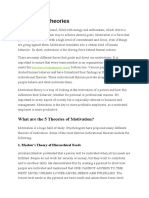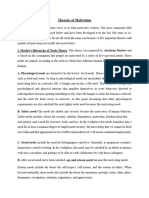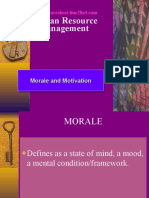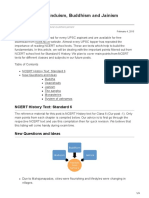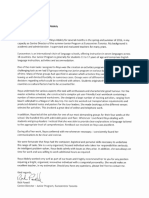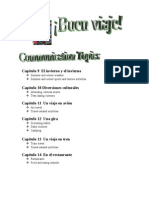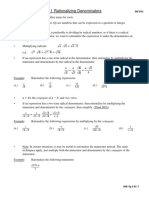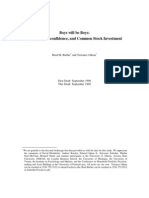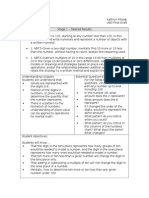Unit 2: Attitude, Values and Motivation
ATTITUDE:
1. An attitude is a mental state of readiness, learned and organized through experience
exerting a specific influence on a person's response to people, objects and situations
with which it is related.
2. Attitudes are learned predispositions towards aspects of our environment. They may be
positively or negatively directed towards certain people, services or institutions.
3. By attitudes means the beliefs, feelings and action tendencies of an individual or group
of individuals towards objects, ideas and people.
4. An attitude can be defined as a positive or negative evaluation of people, objects,
events, activities, ideas, or just about anything in the surrounding environment.
NATURE OF ATTITUDES:
● Attitudes are understood as the beliefs, feelings and action tendencies of an individual or
group of individuals towards objects, ideas and people.
● Attitudes are organized and are core to an individual.
● All people irrespective of their status or intelligence, hold attitudes.
● Attitudes are learned.
● Attitudes refer to feelings and beliefs of individuals or groups of people.
● These feelings and beliefs define one’s predispositions towards given aspects of the
world.
● Attitudes can fall anywhere.
VALUES:
According to me, J. Lehner and N.J. Kube, “Values are an integral part of the personal
philosophy of life by which we generally mean the system of values by which we live.
The philosophy of life includes our aims, ideals, and manner of thinking and the
principles by which we guide our behavior”
Values Characteristics:
An individual's values are part of their DNA, and they tend to have the following characteristics:
● Permanent: values tend to be permanent and generally don't change much, as they are
part of someone's personality.
● Importance: an individual's core values are essential to them. Although one specific
value might not matter to someone, it might mean a lot to someone else. For example,
tradition and religious values might not matter as much to an atheist as to a religious
person.
● Moral compass: someone's values often act as a moral compass and can help them
make decisions that align with their beliefs. For example, an eco-friendly individual who
needs to buy a new car might be more interested in purchasing an electric vehicle rather
than a diesel one.
● Personality: our values are closely related to our personality. Whether we choose a
value based on our personality or our values shape our character, there is a clear link
between the two.
● Subjective: values tend to be subjective; what can be considered a value to someone
might not be for someone else. For example, someone can see themselves as a
traditionalist, but someone else might still see them as a progressivist.
Job Satisfaction: Job satisfaction is defined as the level of contentment employees feel with
their job. This goes beyond their daily duties to cover satisfaction with team
�members/managers, satisfaction with organizational policies, and the impact of their job on
employees’ personal lives.
Job satisfaction has been linked to many variables, including productivity, absenteeism,
turnover, etc. It is significant because a person’s attitude and beliefs may affect his or her
behavior.
The importance of job satisfaction is:
Lower Turnover.
Higher Productivity.
Increased Customer Satisfaction.
Employee Absenteeism.
Helps to Earn Higher Revenues.
Satisfied Employees Tend to Handle Pressure.
What is motivation theory?
Motivation theory looks at what drives people to work towards a specific goal, the
decision-making involved and how it impacts actions and behaviours. It helps us understand
what incentivises people, how a person’s behaviour influences others, what needs they want to
fulfil through their actions and the difference between engagement and motivation. Rather than
simply accepting motivation as a random human quirk, motivation theory uses a
research-backed framework to understand what pushes people forward. Motivation theory
essentially focuses on two key factors:
● Intrinsic factors: People are motivated by a desire to satisfy certain human needs, such
as achieving personal or professional goals or pleasing their employer
● Extrinsic factors: People are motivated by external factors such as a bonus as a
reward for their hard work or a sanction if they fail to meet their targets.
Top 5 motivation theories to use in the workplace
Businesses can build on different motivation theories to create a working environment more
conducive to nurturing enthusiasm and productivity. Here are the five most commonly used in
the workplace:
1. Herzberg’s Two-Factor theory of motivation (or Motivation-Hygiene Theory):
Behavioural scientist Frederick Herzberg developed the Herzberg motivation theory in 1959. It
was the result of interviews conducted with employees where he asked workers to think of a
time they felt good and bad about their job and why. Herzberg concluded that two mutually
exclusive factors influence employee satisfaction and dissatisfaction:
● Motivators: Recognition, perks and opportunities for advancement, which increase
motivation, commitment and productivity
● Hygiene: Includes company policies, supervision, compensation and working conditions
which contribute to consistent employee satisfaction when present and employee
dissatisfaction when absent
Businesses can incorporate elements of Herzberg’s motivation theory into company policy to
increase motivation and hygiene by giving employees more autonomy over their work, providing
regular employee feedback, improving working conditions and continuously reviewing employee
welfare.
�2. Maslow’s Hierarchy of Needs
Psychologist Abraham Maslow published the hierarchy of needs in 1943 in his paper, “A Theory
of Human Motivation”. The Maslow motivation theory outlines the five key tiers of human needs,
represented by a pyramid:
1. Self-actualisation: A person’s ability to reach their full potential
2. Esteem: Recognition, status, self-esteem and respect
3. Love and belonging: Friendships, family, intimacy and a sense of connection
4. Safety needs: Personal security, resources, employment, health, property
5. Physiological needs: Air, food, water, shelter, clothing, sleep, reproduction
People typically strive to achieve their basic needs first, such as food, water and shelter, and
these form the bottom of the pyramid. They then move up to the next pyramid tier until reaching
the very top.The most important takeaway for an employer is that the basic needs must be in
place before anything else. Each tier is built on the other, so employers should first concentrate
on meeting the base requirements. Ensure that everyone is adequately paid and has safe
working conditions and job security. Then, consider ways to make work more rewarding through
job enrichment, cross-training and special projects.
McGregor’s Theory X and Theory Y
The idea that a manager’s attitude has an impact on employee motivation was originally
proposed by Douglas McGregor, a management professor at the Massachusetts Institute of
Technology during the 1950s and 1960s. In his 1960 book, The Human Side of Enterprise,
McGregor proposed two theories by which managers perceive and address employee
motivation. He referred to these opposing motivational methods as Theory X and Theory Y
management. Each assumes that the manager’s role is to organize resources, including people,
to best benefit the company. However, beyond this commonality, the attitudes and assumptions
they embody are quite different.
Theory X
According to McGregor, Theory X management assumes the following:
● Work is inherently distasteful to most people, and they will attempt to avoid work
whenever possible.
� ● Most people are not ambitious, have little desire for responsibility, and prefer to be
directed.
● Most people have little aptitude for creativity in solving organizational problems.
● Motivation occurs only at the physiological and security levels of Maslow’s
hierarchy of needs.
● Most people are self-centered. As a result, they must be closely controlled and
often coerced to achieve organizational objectives.
● Most people resist change.
● Most people are gullible and unintelligent.
Theory Y
The higher-level needs of esteem and self-actualization are ongoing needs that, for most
people, are never completely satisfied. As such, it is these higher-level needs through which
employees can best be motivated.In strong contrast to Theory X, Theory Y management makes
the following assumptions:
● Work can be as natural as play if the conditions are favorable.
● People will be self-directed and creative to meet their work and organizational
objectives if they are committed to them.
● People will be committed to their quality and productivity objectives if rewards are
in place that address higher needs such as self-fulfillment.
● The capacity for creativity spreads throughout organizations.
● Most people can handle responsibility because creativity and ingenuity are
common in the population.
● Under these conditions, people will seek responsibility.








